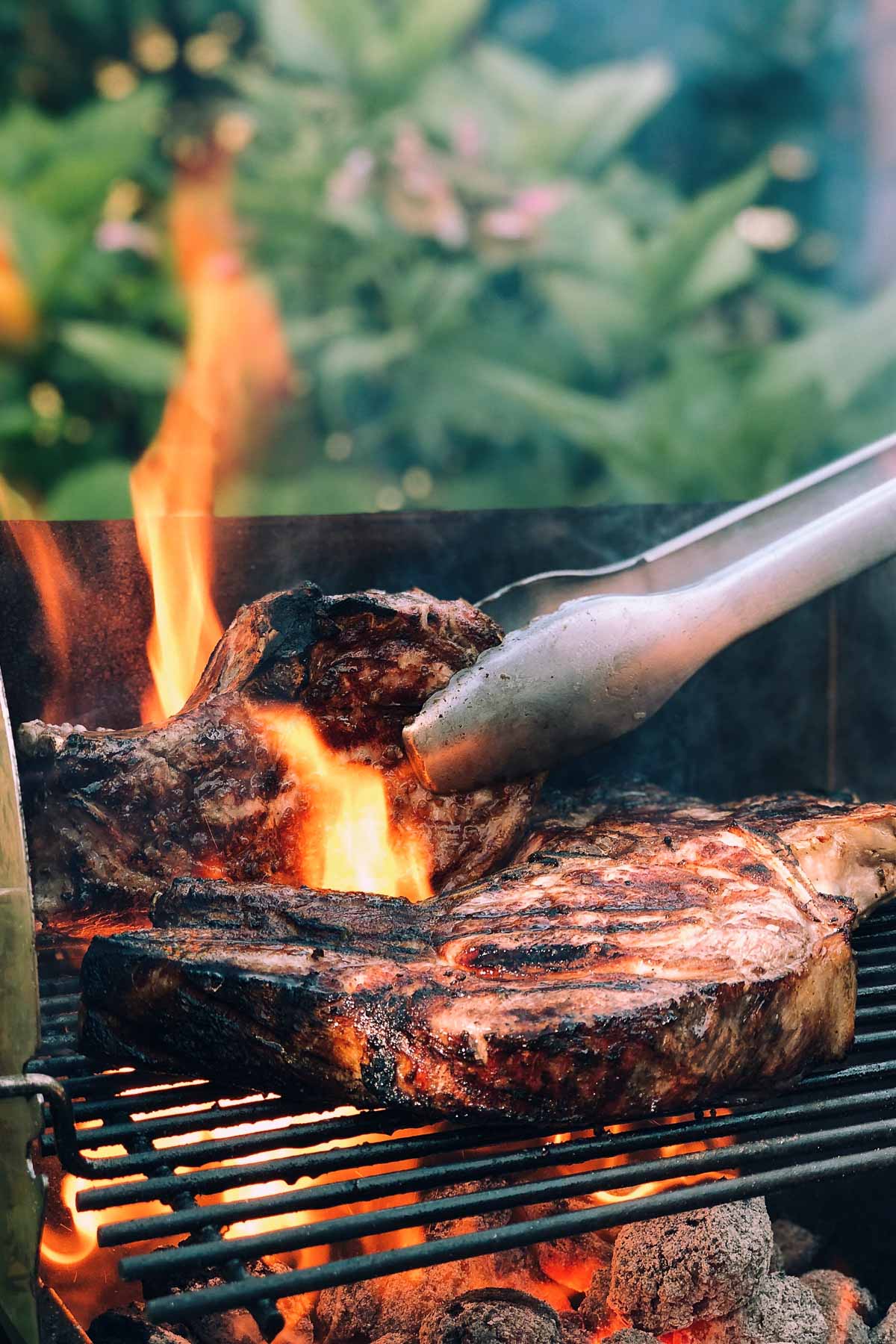Grill steaks temperature isn’t just about the heat of the grill; it’s about understanding how heat interacts with different cuts of meat and how it transforms the texture and flavor of your steak. From the sizzle of the first sear to the final resting period, temperature plays a pivotal role in ensuring your steak is cooked to perfection. Achieving the right balance requires not only the right tools but also a solid understanding of how various temperatures affect the doneness of your steak. With the right knowledge, you can confidently navigate the nuances of grilling and consistently produce mouthwatering results. In this comprehensive guide, we’ll delve into the science of grill steaks temperature, explore the best practices for achieving your desired level of doneness, and provide actionable tips to help you grill like a pro. Whether you’re aiming for a rare, medium-rare, or well-done steak, we’ll equip you with the tools and techniques to ensure every bite is as delicious as the last. So, let’s fire up the grill and dive into the world of perfect steak temperatures!
Table of Contents
- What Is the Perfect Grill Steaks Temperature?
- Why Does Temperature Matter When Grilling Steaks?
- How Can You Measure the Internal Temperature of a Steak?
- What Are the Best Temperatures for Different Levels of Doneness?
- Can You Use a Two-Zone Grilling Method for Better Results?
- How Do You Avoid Common Grilling Mistakes?
- What Are the Best Tools for Grilling Steaks?
- FAQs About Grill Steaks Temperature
What Is the Perfect Grill Steaks Temperature?
When it comes to grilling steaks, the "perfect" temperature depends on a variety of factors, including the cut of meat, its thickness, and your personal preference for doneness. However, as a general rule, the ideal grill steaks temperature for most cuts ranges between 400°F and 450°F (204°C to 232°C). This high-heat range ensures a beautiful sear on the outside while locking in the juices on the inside. But before you crank up the heat, it’s essential to understand how different temperatures can influence the final outcome.
For thinner cuts like flank steak or skirt steak, a slightly lower temperature (around 375°F) may suffice, as these cuts cook quickly and can easily overcook at higher temperatures. On the other hand, thicker cuts like ribeye or filet mignon benefit from the higher end of the temperature spectrum, as they require more time to reach the desired internal temperature without burning the exterior. Additionally, preheating your grill is crucial. A properly heated grill ensures even cooking and prevents the steak from sticking to the grates.
Read also:Who Is Stevie Nicks Guitarist Unveiling The Magic Behind The Music
How to Preheat Your Grill for Optimal Results
Preheating your grill is a step that should never be skipped. To achieve the best results, allow your grill to heat up for at least 10-15 minutes before placing the steak on the grates. This not only ensures a consistent grill steaks temperature but also helps create those coveted grill marks. For gas grills, set the burners to high and close the lid during preheating. For charcoal grills, arrange the coals in a two-zone setup (more on this later) and wait until the coals are covered with a light gray ash.
Choosing the Right Cut for High Heat
Not all steaks are created equal when it comes to high-heat grilling. Cuts with good marbling, such as ribeye or New York strip, are ideal for high temperatures because the fat renders during cooking, adding flavor and moisture. Leaner cuts like sirloin or flank steak may require a slightly lower grill steaks temperature to prevent them from drying out. Understanding the characteristics of each cut will help you tailor your grilling approach for the best results.
Why Does Temperature Matter When Grilling Steaks?
Temperature is the cornerstone of successful grilling. It affects everything from the texture and flavor of the steak to its juiciness and tenderness. When a steak is exposed to high heat, the proteins in the meat undergo a process called denaturation, which causes them to contract and squeeze out moisture. If the grill steaks temperature is too high, the exterior can burn before the interior reaches the desired level of doneness. Conversely, if the temperature is too low, the steak may cook unevenly, resulting in a lackluster crust and a less-than-ideal texture.
Another reason temperature matters is that it directly influences the Maillard reaction—a chemical process that occurs when proteins and sugars in the meat are exposed to heat. This reaction is responsible for the rich, savory flavors and the golden-brown crust that make grilled steaks so irresistible. Achieving the perfect grill steaks temperature ensures that the Maillard reaction occurs without overcooking the steak.
How Does Temperature Affect Juiciness?
Juiciness is one of the most sought-after qualities in a grilled steak, and temperature plays a crucial role in preserving it. As the internal temperature of the steak rises, the muscle fibers contract, forcing out moisture. For example, a steak cooked to medium-rare (130°F to 135°F) retains more juices than one cooked to well-done (160°F and above). By carefully monitoring the grill steaks temperature and using a meat thermometer, you can ensure your steak is cooked to the perfect level of juiciness.
Key Factors That Influence Juiciness
- Thickness of the Steak: Thicker cuts require a higher grill steaks temperature to achieve a good sear without overcooking the interior.
- Resting Time: Allowing the steak to rest for 5-10 minutes after grilling helps redistribute the juices, ensuring a moist and flavorful bite.
- Quality of the Meat: Higher-quality cuts with good marbling naturally retain more moisture during cooking.
Why Is Resting Important After Grilling?
Resting your steak after grilling is just as important as monitoring the grill steaks temperature. When the steak is removed from the grill, the residual heat continues to cook the meat, a phenomenon known as "carryover cooking." Resting allows the juices to redistribute throughout the steak, ensuring a tender and flavorful result. Skipping this step can lead to a steak that loses its juices when sliced, leaving you with a dry and less satisfying meal.
Read also:Mastering Aws Remoteiot Vpc Ssh Download Free A Comprehensive Guide
How Can You Measure the Internal Temperature of a Steak?
One of the most reliable ways to ensure your steak is cooked to perfection is by using a meat thermometer to measure its internal temperature. This simple tool takes the guesswork out of grilling and allows you to achieve consistent results every time. But how exactly do you use a meat thermometer effectively? Let’s break it down step by step.
First, insert the thermometer into the thickest part of the steak, avoiding any bones or fatty areas, as these can give inaccurate readings. For the most accurate results, wait a few seconds after inserting the thermometer before reading the temperature. It’s also important to calibrate your thermometer regularly to ensure its accuracy. A reliable grill steaks temperature guide will help you determine when your steak is ready based on its internal temperature.
What Are the Best Types of Meat Thermometers?
Not all meat thermometers are created equal, and choosing the right one can make a significant difference in your grilling experience. Here are some of the most popular types:
- Instant-Read Thermometers: These provide quick and accurate readings, making them ideal for checking the grill steaks temperature during cooking.
- Leave-In Thermometers: These are designed to stay in the steak while it cooks, allowing you to monitor the temperature continuously.
- Wireless Thermometers: Perfect for multitasking grill masters, these thermometers send temperature updates to your smartphone or a remote display.
Common Mistakes to Avoid When Using a Thermometer
- Inserting the thermometer too early, which can cause the steak to lose juices prematurely.
- Failing to clean the thermometer probe between uses, which can lead to cross-contamination.
- Relying solely on the grill’s built-in thermometer, which may not accurately reflect the steak’s internal temperature.
How to Calibrate Your Meat Thermometer
Calibrating your meat thermometer is a simple process that ensures accurate readings. To do this, fill a glass with ice water and insert the thermometer probe. The temperature should read 32°F (0°C). If it doesn’t, adjust the thermometer according to the manufacturer’s instructions. Regular calibration is especially important when working with high grill steaks temperatures, as even a small discrepancy can affect the final outcome.
What Are the Best Temperatures for Different Levels of Doneness?
Every steak lover has their preferred level of doneness, and achieving it requires precise control over the grill steaks temperature. Whether you’re a fan of rare, medium-rare, or well-done steaks, understanding the ideal internal temperatures for each level is key to grilling success. Here’s a breakdown of the best temperatures for different levels of doneness:
- Rare: 120°F to 125°F (49°C to 52°C) – Cool red center with a soft texture.
- Medium-Rare: 130°F to 135°F (54°C to 57°C) – Warm red center with a juicy and tender bite.
- Medium: 140°F to 145°F (60°C to 63°C) – Pink center with a firmer texture.
- Medium-Well: 150°F to 155°F (66°C to 68°C) – Slightly pink center with minimal juiciness.
- Well-Done: 160°F and above (71°C and above) – Little to no pink with a firm texture.
How to Adjust Grill Steaks Temperature for Different Cuts
Different cuts of steak require different approaches to achieve the desired level of doneness. For example, a thick-cut ribeye may need a slightly lower grill steaks temperature to ensure the interior cooks evenly without burning the exterior. Conversely, a thin-cut sirloin may require a higher temperature to achieve a good sear without overcooking. Experimenting with different temperatures and techniques will help you find the perfect balance for each cut.
Tips for Achieving Your Preferred Doneness
- Use a meat thermometer to monitor the internal temperature closely.
- Adjust the grill’s heat as needed to prevent burning or undercooking.
- Allow the steak to rest before slicing to lock in the juices.
Why Is Medium-Rare Often Considered the Sweet Spot?
Many steak enthusiasts consider medium-rare to be the sweet spot for grilling. At this level of doneness, the steak is warm and juicy, with a tender texture and a rich, beefy flavor. The grill steaks temperature for medium-rare is typically around 130°F to 135°F, making it an ideal choice for those who want the best of both worlds—flavor and juiciness.
Can You Use a Two-Zone Grilling Method for Better Results?
One of the most effective techniques for grilling steaks

